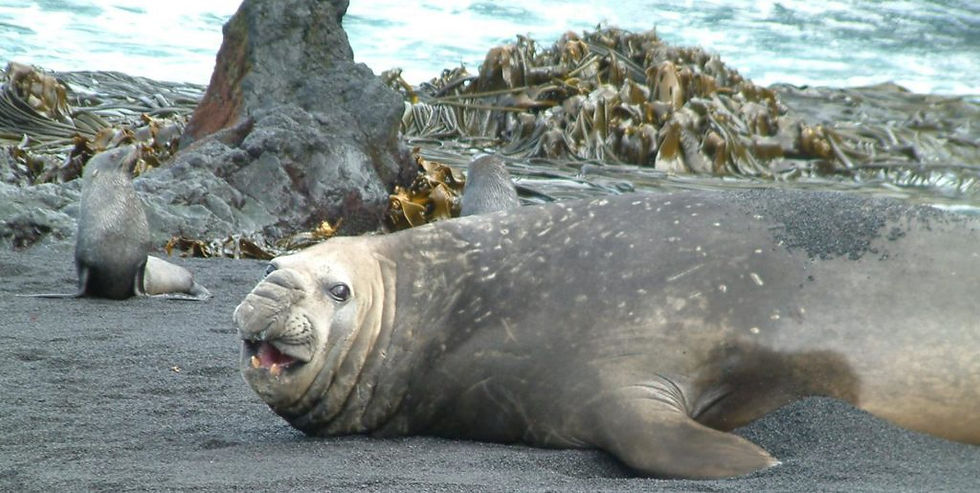It's Official! Invasive Species are Everywhere
- N Wong
- Aug 30, 2018
- 3 min read
Antarctica broke away from Gondwana over 40 million years ago and until recently researchers have thought that the mixture of ocean currents, the substantial distance from anywhere and temperature have kept Antarctica free of invasion by Pacific or Atlantic flotsam. Flotsam is broadly defined as material or refuse floating on water. Flotsam as a vector for the transport of invasive is becoming better acknowledged. Just ask beach goers on the west coast of North America following the devastating earthquake that struck north-eastern Japan in 2011.
I digress, Antarctica’s biological isolation has now been officially and surprisingly non-anthropogenically disrupted. With parts of Antarctica among the most rapidly warming regions on Earth, it is fast becoming hospitable to diverse taxa from lower latitudes. A recent study by Australian, Chilean, New Zealand, South African and Dutch researchers published in Nature Climate Change used population genomic analysis and oceanic modelling to elucidate the origins of some non-Antarctic kelp rafts that turned up on Antarctic beaches. In early 2017, thalli of the keystone southern bull kelp, Durvillaea antarctica, a buoyant cold-temperate species with a sub-Antarctic distribution were collected from beaches on King George Island, Antarctica. Normally, the kelp is absent from Antarctica and all islands south of the Southern the Antarctic Circumpolar Current (ACC) front. One thallus had large goose barnacles (Lepas australis) attached to it, indicating that it had probably been
adrift at sea for quite a long time.

An elephant seal basks beside Durvillaea kelp growing on sub-Antarctic Marion Island. Image: By Dr Ceridwen Fraser

Goose barnacles (Lepas australis) fouling a piece of driftwood Photo: Cowchilla
Kelp rafts like this represent a stable buoyant substrate for invertebrates (including molluscs, arthropods and echinoderms) and algae, and can also house fish species that drift passively along. Using genetics, the research team compared single nucleotide polymorphisms (SNPs) from the collected Antarctic kelp with that of established populations throughout the species’ native range. The results confirmed that the kelp rafted to Antarctica from two different mid-latitude locations, Kerguelen (49 °S) and South Georgia (54° S). The kelp astonishingly travelled over 20,000 km and crossed several ocean-front barriers. High resolution ocean circulation models also demonstrated that storm-forced surface waves and ocean eddies can dramatically increase connectivity and that Antarctica is really not biologically isolated. This finding begs the question as to how frequent rafting events like these are or are they anomalous?
This finding shows us that living plants and animals can reach Antarctica across the ocean, with temperate and sub-Antarctic marine species probably bombarding Antarctic coastlines all the time,” said Ceridwen Fraser, of the Australian National University.
“We always thought Antarctic plants and animals were distinct because they were isolated, but this research now suggests these differences are almost entirely due to environmental extremes, not isolation.”
Modelling of drift particles from South Georgia to Antarctica found that 72% reached the target from 489 days to as long as two years. D. Antarcticacan live for several years and many of its potential passengers are brooding taxa whose offspring could raft for multiple generations. This data demonstrates that natural invasive species transport to Antarctica is a reality. This also highlights the potential for drift of a wider variety of floating material… like plastics. You may have heard these are an issue in the oceans too.
For this fascinating article find the full text here:
https://www.researchgate.net/publication/326424695_Antarctica%27s_ecological_isolation_will_be_broken_by_storm-driven_dispersal_and_warming
https://www.nature.com/articles/s41558-018-0209-7
Fraser, C.I., Morrison, A.K., Hogg, A.M., Macaya, E.C., van Sebille, E., Ryan, P.G., Padovan, A., Jack, C., Valdivia, N. and Waters, J.M., 2018. Antarctica’s ecological isolation will be broken by storm-driven dispersal and warming. Nature Climate Change, p.1.





Comments